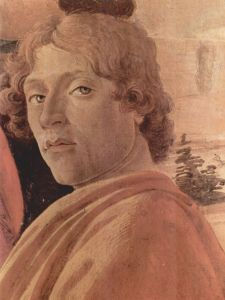Sandro Botticelli is the nickname of Alessandro di Mariano Filipepi who was an Italian painter, draftsman and engraver from the Renaissance.
He was the Mariano Filipepi‘s fourth and smallest son and his father was a tanner. Mariano Filipepi’s desire was to make his young son Sandro (diminutive of Alessandro) to learn the same trade and continue the familiar business. Botticelli showed to have an art bent and it made his father to find an occupation appropriate to the child’s likings. Then, Botticelli became apprentice of a young man called Botticello, which is the Italian diminutive of the word “barrel” and it probably made reference to his obesity, who protected and adopted him. Botticelli was nicknamed after Botticello and it is assumed that he could be Botticelli’s brother, who was a silversmith.
His life was not as outstanding as his great contemporaries’ life. He met Leonardo Da Vinci when he was invited to paint in The Sistine Chapel in the Verrochio’s studio. He was influenced by Girolamo Savonarola, whose apocalyptic sermons he preached against the pagan art and his proposals of art as a theological instrument, made an impression on Botticelli to such an extent that he burnt some of his pagan works. Botticelli’s work suffered then a radical change. He gave up definitely the mythological subject and he devoted his life to produce religious painting.
He had Fra Filippo Lippi and Antonio Pollajuola as his masters. He discussed with Antonio Pollajuola in Verrochio’s studio, where philosophers and artists met. As a result of this environment appears the Boticelli’s predilection for the subjects he tackled in his artworks, which place him in the group of Renaissance painters of his country.
According to Salomón Reinach, not being and not meaning to be a colourist, Botticelli highlighted with colour the continuous and contagious “tremolo” of his lines. When his work is as admirable as in Primavera which is housed in Uffizi Gallery of Florence, he offers the most perfect expression of the human and the Florentine distinction’s quintessence.
His religious paintings are not so different from those that were about profane subjects because of their free, fluent and a slightly sensuous style. The similarity in the means and the sensibility is surprising in the Virgin and the Venus; or in the religious Angels and in the profane Graces. His work is different because of the lyrical qualities of the line and the colour, in addition to the almost perfect balance between objects and figures. It is noticed in his famous painting The Birth of Venus where Botticelli gets an obsessive circular effect due to the roundness appreciated in the central neoclassical figure’s shoulder, the dresses waved by the wind in some figures and the circular shell Venus is placed in.
Assigned by the Médicis family, Botticelli painted the illustrations for Dante’s Divine Comedy. This fact has allowed Walter Pater to say that it was necessary to wait till the fifteenth century and Botticelli’s collaboration to make Dante to have his work illustrated.
Botticelli painted, in addition to the above-mentioned artworks: Madonna of the Magnificat, St. Augustine and Judith Leaving the Tent of Holofernes placed today in Florence and Portrait of a Young Man in Washington.


